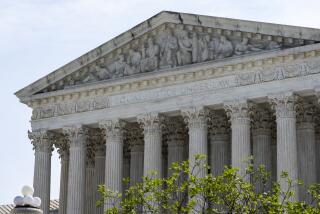Vouchers Hinder School Reform
- Share via
In the petition he filed last year on behalf of the Bush administration, U.S. Solicitor General Theodore B. Olson urged the U.S. Supreme Court to hear an appeal of a Cleveland school voucher case, which he said involved a program assisting “the parents of students enrolled in failing public schools.”
Olson was successful--in more ways than one.
Not only will the high court hear oral arguments in the case today, but parents, elected officials and reporters are also largely accepting Olson’s erroneous description of the Cleveland program.
As the Supreme Court prepares to hear this case, it must not allow its judgment to be clouded by the myth that vouchers are helping children trapped in “failing” schools. The nine justices must recognize that how they decide the case could encourage other states down a dangerous path that drains critical funds from public schools and the students they serve.
The voucher program the high court will examine operates very differently than its defenders would have Americans believe.
Besides diverting more than $10 million from education budgets in this school year alone, the program funnels tax dollars to many families whose children either never attended public schools or, if so, attended quality public schools.
Last year, an Ohio research institute reviewed information from the voucher program’s applications. What it found was stunning. Only 21% of the students receiving state tuition aid through the program had attended a Cleveland public school the previous year.
Far from having “escaped” public schools, nearly eight out of 10 voucher students were already attending private schools or were just starting kindergarten.
For those voucher students who can be traced back to the public schools, relatively few were attending failing schools.
Catalyst for Cleveland Schools, an organization that reports on reform efforts, examined the 10 public schools that had lost the most students to vouchers. Rather than support the myth of vouchers as a life raft for students in failing schools, the organization found that these 10 schools were more likely to have test scores above the district average--in some cases, above the state average.
Additionally, six of these 10 schools were classified among the district’s “empowered” schools, chosen for overall excellence. Three of these 10 schools were among 1,320 high-poverty, high-minority public schools highlighted in a recent report by the Education Trust for their high performance. Not one of the these 10 schools was on the Cleveland Municipal School District’s list of low-performing public schools.
This is not to suggest that there aren’t public schools that need significant improvement. But funneling tax dollars to vouchers undercuts the ability to fund smaller classes, early intervention, after-school programs and other reforms that can turn around troubled schools.
Another myth is the notion that vouchers give Cleveland parents a wide diversity of choices, including suburban public schools. While the voucher law permits suburban public schools to participate, not a single suburban public school does so.
In addition, data released earlier this month show that 99.4% of voucher money flows to religious schools. While there were once 11 nonreligious schools that participated in the Cleveland program, that number has fallen to only three. In fact, the law is structured in a way that encourages this. For parents who don’t want a religiously based education, there is virtually no choice.
Speaking before the Supreme Court, pro-voucher attorneys are likely to portray their effort as a crusade to help kids in failing public schools.
But repetition doesn’t turn a myth into a reality. During arguments in a 1770 trial, John Adams put it best: “Facts,” he said, “are stubborn things.”
*
Ralph G. Neas is president of People for the American Way Foundation, which is serving as co-counsel for plaintiffs in the voucher case.
More to Read
Sign up for Essential California
The most important California stories and recommendations in your inbox every morning.
You may occasionally receive promotional content from the Los Angeles Times.













